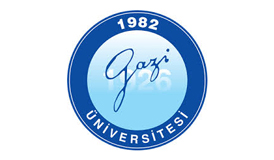Research Article
Level of Electromagnetic Radiation Emitted from Mobile Phone Base Station during F1 Race in the Kingdom of Bahrain
1Department of Physics, College of Science, University of Bahrain, Kingdom of Bahrain
2Department of Architecture and Interior Design, College of Engineering, University of Bahrain, Kingdom of Bahrain
*Corresponding author: Waheeb E Alnaser, Professor, Department of Physics, College of Science, University of Bahrain, Bahrain, E-mail: walnaser@uob.edu.bh
Received: August 20, 2019 Accepted: August 28, 2019 Published: September 4, 2019
Citation: Alnajjar H, Alnaser NW, Alnaser WE. Level of Electromagnetic Radiation Emitted from Mobile Phone Base Station during F1 Race in the Kingdom of Bahrain. Int J Phys Stud Res. 2019; 2(1): 65-70. doi: 10.18689/ijpsr-1000109
Copyright: © 2019 The Author(s). This work is licensed under a Creative Commons Attribution 4.0 International License, which permits unrestricted use, distribution, and reproduction in any medium, provided the original work is properly cited.
Abstract
Measuring the power density of the Electromagnetic Radiation (EMR), or Radio frequency radiation, emitted from the mobile base station (transmitting mast) during three days event of Formula 1 Race in 4th, 5th and 6th April 2008 at Bahrain International Circuit, Kingdom of Bahrain, revealed that the exposure to EMR is much lower than the allowable limit set by several professional organization (seven organizations); it represents less than 0.1%. The instantaneous recorded power density at distances 160 m, 230 m and 300 m from the transmitting mast were, on average, 46.5 μW/m2, 86.8 μW/m2, 395.8 μW/m2, respectively. The highest recorded instantons power density during the whole event was 901 μW/m2 and was on Sunday afternoon of 6th April 2008, where it was the winner announcing day.
The long- term recorded power density during this international event shows lots of variation during this 90 minutes recording in last day (Sunday) of the event which is winner announcement event. This indicates that F1 spectators do substantial number of phone calls during the events where the variation in this day was from 0.607 μW/m2 to 16.832 μW/m2 while in Saturday was from 0.313 μW/m2 to 5.455 μW/m2 and in Friday was from 0.139 μW/m2 to 2.356 μW/m2.
Keywords: Electromagnetic Radiation (EMR); Radio frequency radiation; Power density; Formula 1; Bahrain International Circuit.
Introduction
The Bahrain International Circuit (BIC) is a motorsport venue opened in 2004 and used for the annual Bahrain Grand Prix (Formula 1 race). The 2004 Grand Prix was the first held in the Middle East. The construction of the Bahrain circuit was a national objective for Bahrain, initiated by the Crown Prince (H R H Shaikh Salman bin Hamad Al Khalifa) who is the Honorary President of the Bahrain Motor Federation. In 2007 the circuit became the first Grand Prix circuit to be awarded the distinguished FIA Institute Centre of Excellence award, given for excellent safety, race marshal, and medical facilities, and for the high standards of technology required to maintain these [1]. The circuit was designed by German architect. The main contractor for the project was a Bahraini company (Cebarco-WCT). The circuit cost was approximately BD 56.2 million (US$150 million) to construct. BIC has six separate tracks, including a test oval and a drag strip. More information on Architectural and Environmental Aspects of the circuit can be found elsewhere [2,3].
About 28,000 spectators watched the race and the top year for Bahrainʼs Grand Prix was in 2008, when the race attracted 30,000 fans [4]. During the Formula 1 lots of Fans used their mobile phone heavily, and accordingly, the power density from the mobile phone base station (transmission mast) is expected to increase substantially. The concern about the Electromagnetic Radiation (EMR) emitted from transmitting mast becomes widely spread with lots of either exaggeration or under estimation. Therefore, lots of research were conducted to measure the levels of the radiation emitted from such transmitting mast either in schools, heavy population areas but no one had made measurement on such level in an international popular competition like FI Race.
Wood [5] reviewed the strength of the available epidemiological and laboratory evidence of the effect of EMR and notes that it falls short of what is normally required to establish a causal link. He reported low levels of power density which is up to a few thousandths of the permitted levels. However, it raises the importance of continuous and wholebody nature of the exposure of such radiation remembering that mobile phone transmissions are only part of the spectrum of EMF transmissions, along with radio, TV, and other communications networks.
Exposure to radiofrequency (RF) radiation was classified in 2011 as a possible human carcinogen, Group 2B, by the International Agency for Research on Cancer of the World Health Organization [6] although the RF radiation ( or EMR) is a non-ionizing radiation but has sufficient intensity to slightly heats tissues. Hardell et al. [6] made a total of 74,531 measurements corresponding to nearly 83 h of recording. The total mean RF radiation level was found equal to 3,811 μW/m2 (ranging from 15.2 to 112,318 μW/m2) for the measurement of the whole apartment, including balconies. The closest base stations were only 6 m from the balcony outside the tower. Surprisingly, they concluded that the apartment is not suitable for long-term living because of this level of radiation, particularly for children who may be more sensitive than adults.
Meo et al. [7] had reported that high exposure to RF-EMF produced by mobile phone base station towers (MPBSTs) was associated with delayed fine and gross motor skills, spatial working memory, and attention in school adolescents compared to students who were exposed to low RF-EMF. Their study [7] is to investigate the impact of exposure to radiofrequency electromagnetic field (RF-EMF) radiation generated by MPBSTs on cognitive functions. They used 217 volunteer male students (aged between 13 and 16) registered from two different intermediate schools: 124 students were from School 1 and 93 students were from School 2. The MPBSTs were located within 200 m from the school buildings. They found that that the RF-EMF in School 1 was 2.010 μW/cm2 (20.1 mW/m2) with a frequency of 925 MHz and in School 2 was 10.021 μW/cm2 (100.2 mW/m2) with a frequency of 925 MHz. The students were exposed to EMFR for 6 hrs a day, 5 days a week for a total period of 2 years.
Buckus et al. [8] presented and analyzed EMFs generated by mobile telephone base station antennas in areas accessible to the general public. Measurements of the RF electric field strength and RF EMF power density were conducted in the near- and far-fields of the mobile telephone base station antenna. Their tests, which were performed on the roof in front of the mobile telephony base station antennas in the near-field, revealed the presence of a dynamic energy interaction within the antenna electric field which changes rapidly with distance. The RF EMF power density values on the ground at distances of 50, 100, 200, 300, 400, and 500 m from the base station are very low and are scattered within intervals of 0.02 to 0.50 mW/m2. The results were compared with international exposure guidelines (ICNIRP).
Chiaramello et al. [9] presented an overview of the last ten years research efforts about RF EMF exposure in indoor environments, considering different RF-EMF sources found to cause exposure in indoor environments, different indoor environments and different approaches used to assess the exposure. They reported that the highest maximum mean levels of the exposure, considering the whole RF-EMF frequency band, was found in offices (1.14 V/m) and in public transports (0.97 V/m), while the lowest levels of exposure were observed in homes and apartments, with mean values in the range 0.13–0.43 V/m [9]. In their study they converted power density to Electric field strength (V/m) by:

where Z0, equal to 377 and Ω is the impedance of vacuum. Gallastegi et al. [10] studied RF-EMF exposure in the Spanish children by spot and personal measurements in the locations in order to identify which locations and sources contribute most to the level of exposure. 104 children (of age 8 years) were involved: spot measurements were conducted in homes, schools and their play grounds and parks. Results showed that median exposure levels ranged from 29.73 μW/m2 (0.11 V/m, 0.38% of the ICNIRP reference level) in childrenʼs bedrooms to 200.10 μW/m2 (0.27 V/m, 0.88% of the ICNIRP reference level) in school playgrounds for spot measurements and were higher outdoors than indoors. The sources that contributed most to the exposure were FM radio, mobile phone downlink and Digital Video Broadcasting-Terrestrial, while indoor and personal sources contributed very little. Due to rapid use of mobile phones (hence transmitting masts) public concern about the harmful effects of radiation emitted by these devices had grown. Therefore, Shahbazi-Gahrouei et al. [11] had used stem cells to assess the effects of radiofrequency electromagnetic fields (RF-EMF) on other cell lines. The effects of GSM 900 MHz on growth and proliferation of mesenchymal stem cells, derived from adipose tissue, within the specific distance (20 cm) and intensity (354.6 μW/cm2) with 5 times exposure was studied. They concluded that 900 MHz RF signal radiation from antenna can reduce cell viability and proliferation rates of human Adipose-derived stem cells (ADSCs) regarding the duration of exposure [11].
In fact, this study is a unique since it measures level of EMR radiation from mobile base station (transmitting mast) during the three-days international event (Formula one Race) in 2008 (4th, 5th, 6th April 2008) at the kingdom of Bahrain with an attendance of about 28,000 fans in the last day of the event.
Methodology
The RF radiation measurements emitted from the mobile phone base stations at Bahrain International Circuit in AlZallaq area, kingdom of Bahrain (South of Bahrain and about 2 km from University of Bahrain) were recorded using a portable spectrum analyser connected to antenna. The spectrum analyzer model is SPECTRAN® HF-6080 which is the best model among various models of HF detectors made by Aaronia AG, Germany (Figure 1). Some of the most important specifications of the devices are:
- Frequency range: 1 MHz to 7 GHz
- Level range: -90 dBm to 30 dBm
- Power flux density range: 10 fW/m2 to 100 W/m2 (where fW=10-15 W)
- Filter bandwidth range: 10 KHz to 50 MHz
- Precision base unit +/- 3 dBm
The antenna connected to the spectrum analyser, HyperLOG® 6080, is a logarithmic-periodic antenna and it is a single broadband antenna for the complete frequency range from 680 MHz to 18 GHz. The antenna is calibrated precisely in the Aaronia laboratories before dispatch. Its gain is 5 dBi and it has integrated 5/8” tripod socket and its dimensions is (340 × 200 × 25) mm.
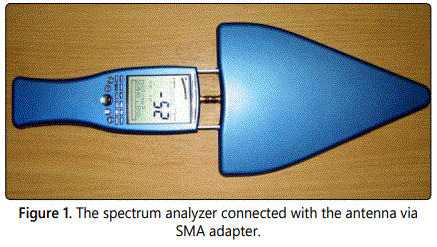
Other equipment used in this research is tripod, adopter and five meters extension cable for long term (24 hours) measurements.
Three softwares were used in this study. First, the software used in processing and analyzing data is the Microsoft® office excel 2003 program. The second software is “Google Earth” which was used to specify the locations of the base stations and to determine the distance between each base station and the point of measurement. The third software used is SPECTRAN spectrum analyzer software “LCS” which was used in downloading the data saved in the spectrum analyzer during the long term measurements.
We had performed two types of measurements for the level of radiation emitting from the mobile base station. First is Instantons at different distances from the transmitting mast (160 m, 230 m and 300 m) (as shown in figure 2) and the second is relatively long-term (90 min) at 310 m from the transmitting mast (as shown in figure 3). The measurements were made in every day of the 3-days international event at different time – according to the race schedule.
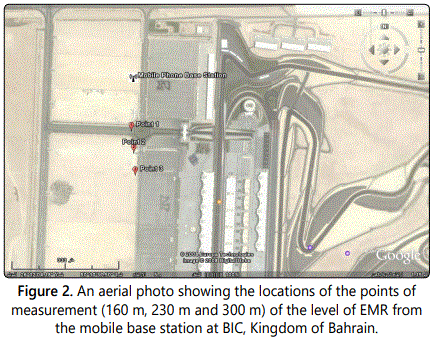
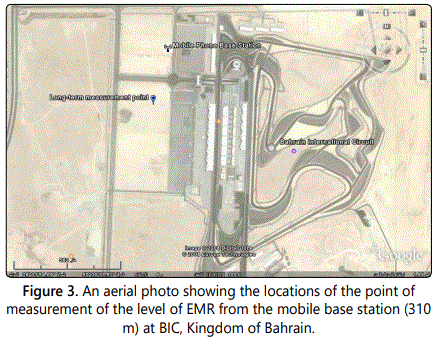
For the long-term power density measurement the device saves the data in dBm unit. To convert this unit (dBm) to μW/m2 the following equation is used in accordance to the manual provided by the manufacturer of the detector (AARONIA AG, Germany):

where P is the measurement in dBm, G is the Antenna gain (G=5.0 dBi for the used detector), λ is the wavelength of the wave (λ=3.0 × 108 (m/s)/9.5 × 108 (Hz)). For example, for – 40 dBm at 950 MHz with Hyper LOG 6080 antenna (which offers a gain of 5.0 dBm at 950 MHz ) the equivalent power density in W/m2 is 0.000002135 which is equal to 2.135 μW/m2.
The long-term power density measurement provides an idea on the variation of RF during a day. Moreover, it shows the maximum and minimum and therefore how much time lapse between them. This help in knowing also how the result in type one of measurements (environmental measurements) changes when the measurement conducted on another time of the day.
Results and Discussion
The events of Formula 1 Race in 2008 were in three days starting on Frid.ay 4th April and ending on Sunday 6th April. Each day two events are made; one in the morning and the other in the afternoon. Tables 1 to 4 shows the results of such measurements with substantially highest attendance from fans (about 28,000) on the final day (6th April 2008) due to announcing the winner accompanied and followed by several entertainments. The other days has much less attendances from fans. This explains why the level of radiation (901 μW/m2) in the last day (Sunday at 2:00 pm) is about 20 times more than the average recorded level, excluding the level of EMR on Friday 4th April 2008 (456 μW/m2) which is about half the level recorded in the final event.




For the long-term EMR emitting from the mobile base tower at a distance of 310 m from the detector we had conducted 4 sets of measurements each is lasting 90 minutes. The results are displayed in tables 5-8.
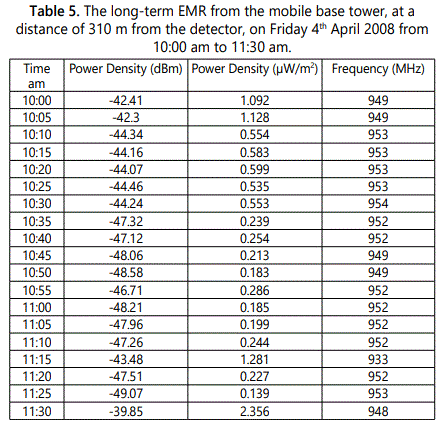
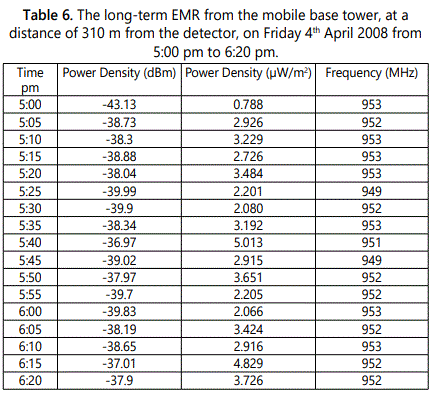
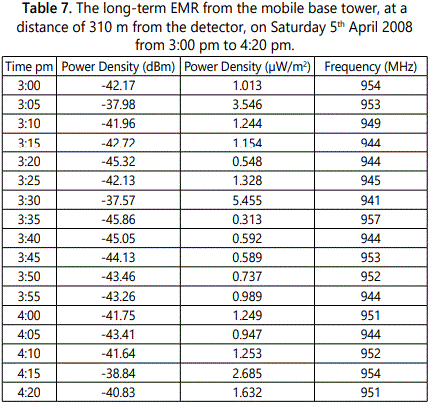
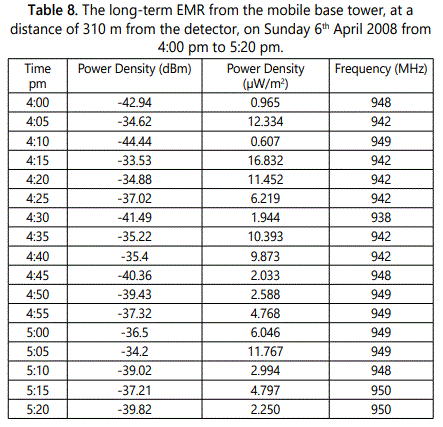
The long-term results (Tables 6-9) shows that the variation in the recorded power density with time is more significant in Sunday than the other two days (Saturday and Friday) which indicates that spectators are using their phone while attending the last events of F1 race very frequently. The variation in the time lapse (90 min) in Friday is from 0.139 μW/m2 to 2.356 μW/m2 in the morning session (Table 5) and from 0.788 μW/m2 to 5.013 μW/m2 in the afternoon session (Table 6). In Saturday the variation was from 0.313 μW/m2 to 5.455 μW/m2 (Table 7) while in Sunday the variation was from 0.607 μW/m2 to 16.832 μW/m2 (Table 8).
The way the mobile phone network operates as follows [12]: When a call is made from a mobile phone, RF signals are transmitted between its antenna and the antenna at a nearby transmitting mast. The phone call is then routed through the phone network to the destination phone. Therefore, base station antennas must be elevated and located clear of physical obstruction to ensure wide coverage.
Therefore, in international or popular sport (like F1 race) or social events, where mobile phones are expected to be used very frequently, an additional number of base stations is needed to maintain service quality increases, even in areas where mobile network coverage already exists. Good service quality will reduce consumption of batteries of the mobile phone and prevent heating of the battery as power is drawn from battery to enable the phone to send the signal. In fact if this is not done the mobile network will not operate properly and, as a result, mobile phone users may not be able to connect to their network [12].
The BioInitiative Report (2012) – updated 2014-2019 [13] defined the scientific benchmark for possible health risks as 30 to 60 μW/m2. Considering also chronic exposure and the sensitivity of children, the precautionary target level was proposed at 1/10th of this, i.e., 3–6 μW/m2 [13] but since this exposure target level has not been acknowledged by the Swedish Radiation Safety Authority (SSM) then it becomes questionable.
The exposimeter in World Health Organization (WHO) building in Geneva on 3 March 2017 recorded a low mean total exposure level of 21.5 μW/m2, median 13.3 μW/m2 (range min 4.8, max 433 μW/m2) [14], i.e., a mean level below the scientific benchmark of 30 to 60 μW/m2 which has been proposed as the ‘lowest observed effect level’ (LOEL) for RF radiation [15]. In the Kingdom of Bahrain, the recommended exposure limit of power density is 0.1 W/m2 (100,000 μW/m2) which is set by the Pollution Control Section, Supreme Environmental Council.
Table 9 lists different reference levels for save general public exposure for frequency band of GSM 900 (925–960 MHz) set by different professional and specialized organizations such as International Commission on Non-Ionizing Radiation Protection (ICNIRP), National Radiological Protection Board (NRPB), Institute of Electrical and Electronics Engineers (IEEE), Federal Communications Commission (FCC), The Australian Radiation Protection and Nuclear Safety (ARPANS).

The save limits set in table 10 is too far larger than that set Bioinitiative Report 12. Considering the highest peak level measured within the WHO building (432.3 μW/m2) – measured at 15:54:07 in 3rd March 2017, then the recorded radiation during F1 Race in April 2008 in Bahrain is considered to be very save in general, except in the last day. It has to be noted that most contribution of radiation in WHO building was from GSM 1800 (DL), 268.2 μW/m2, and UMTS 2100 (DL), 110.4 μW/m2. This was measured just inside the building at the entrance and represent RF radiation from base stations in the vicinity [15].
Luckily, the occurrence of EMR changes rapidly with distance and they scattered in different directions toward the ground as this radiation carry non-ionizing radiations but have a heat effect known as biological effects on human health [6]. This means that the power density recorded during F1 Race in April, 4th to 6th, 2008 in Bahrain was just about to be save. This means more mobile base stations must be installed to reduce the power density.
Conclusion
The power density emitted from the mobile base station (transmitting mast) during the three days event in April 2008 (4th, 5th and 6th) of F1 race (Formula 1) at Bahrain International Circuit is much lower than that set by several professional organization (7 organizations); it represents less than 0.1% while if it is compared to that set by Bioinitiative Report 12 it is considered as within the satisfactory limit.
The instantaneous recorded power density at distances 160 m, 230 m and 300 m from the transmitting mast were, on average, 46.5 μW/m2, 86.8 μW/m2, 395.8 μW/m2, respectively. The highest recorded instantons power density during the whole event was 901 μW/m2 and was on Sunday afternoon of 6th April 2008, where it was the winner announcing day.
The long-term recorded power density during this international event shows lots of variation during this 90 minutes recording in last day (Sunday) of the event which is winner announcement event. This indicates that F1 spectators do substantial number of phone calls during the events where the variation was from 0.607 μW/m2 to 16.832 μW/m2 while in Saturday was from 0.313 μW/m2 to 5.455 μW/m2 and in Friday was from 0.139 μW/m2 to 2.356 μW/m2. This leads to the suggestion of installing more transmitting masts for better quality signal and less power density transmitting.
Acknowledgment
The authors would like to thank University of Bahrain for providing all facilities to enable the researchers to conduct this study. Special thanks to Dr Lama Sakhniny, Department of Physics, College of Science for her technical assistance and discussions. Thanks to the administration of BIC to provide the facilities to conduct the measurements during the F1 race events.
References
- Bahrain named Centre of Excellence by FIA. Formula1.com.
- Alnaser WE, Flanagan R, El-Masri S, Al-Khalifa SE, Probert SD, Alnaser NW. Bahrainʼs Formula-1 Racing Circuit: Energy and Environmental Considerations. Applied Energy. 2006; 83(4): 352-370. doi: 10.1016/j.apenergy.2005.04.006
- Alnaser NW, Flanagan R, Al-Khalifa SE, Mumtaz R, El-Masri S, Alnaser WE. Architectural, Construction and Environmental matters of Bahrainʼs International Formula1 Circuit. Building and Environment. 2007; 42(4): 1783-1794. 10.1016/j.buildenv.2006.01.014
- Lifestyle. Bahrain F1 race watched by 28,000 fans.
- Wood AW. How dangerous are mobile phones, transmission masts, and electricity pylons? Arch Dis Child. 2006; 91(4): 361-366. doi: 10.1136/adc.2005.072561
- Hardell L, Carlberg M, Hedendahl LK. Radiofrequency radiation from nearby base stations gives high levels in an apartment in Stockholm, Sweden: A case report. Oncol Lett. 2018; 15(5): 7871-7883. doi: 10.3892/ol.2018.8285
- Meo SA, Almahmoud M, Alsultan Q, Alotaibi N, Alnajashi I, Hajjar WH. Mobile Phone Base Station Tower Settings Adjacent to School Buildings: Impact on Studentsʼ Cognitive Health. Am J Mens Health. 2019; 13(1): 1-6. doi: 10.1177/1557988318816914
- Buckus R, Strukčinskienė B, Raistenskis J, et al. A Technical Approach to the Evaluation of Radiofrequency Radiation Emissions from Mobile Telephony Base Stations. Int J Environ Res Public Health. 2017; 14(3): 244-254. doi: 10.3390/ijerph14030244
- Chiaramello E, Bonato M, Fiocchi S, et al. Radio Frequency Electromagnetic Fields Exposure Assessment in Indoor Environments: A Review. Int J Environ Res Public Health. 2019; 16: 955-984. doi: 10.3390/ijerph16060955
- Gallastegi M, Huss A, Santa-Marina L, et al. Childrenʼs exposure assessment of radiofrequency fields: Comparison between spot and personal measurements. Environ Int. 2018; 118: 60-69. doi: 10.1016/j.envint.2018.05.028
- Shahbazi-Gahrouei D, Hashemi-Beni B, Ahmadi Z. Effects of RF-EMF Exposure from GSM Mobile Phones on Proliferation Rate of Human Adipose-derived Stem Cells: An In-vitro Study. J Biomed Phys Eng. 2016; 6(4): 243-252.
- Arpansa. Mobile phone base stations and health. Australian government.
- Sage C, Carpenter DO. Key Scientific Evidence and Public Health Policy Recommendations. In: BioInitiative Working Group: BioInitiative Report 2012: A Rationale for Biologically-based Public Exposure Standards for Electromagnetic Radiation.
- Hardell L. World Health Organization, radiofrequency radiation and health-a hard nut to crack (Review). Int J Oncol. 2017; 51(2): 405-413. doi: 10.3892/ijo.2017.4046


